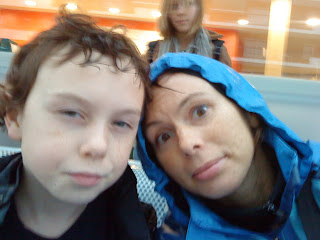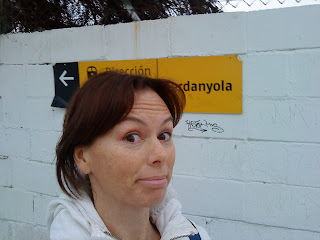The Way of St James/Camino de Santiago
Departure for the Camino de Santiago: We leave on the 1st of May, and are back in Granollers on the 26th of May 2010
Our Route:

For a larger version of this map, click this link. We're starting from Lagrono. Its the most famous of all of the routes, otherwise called 'The French Way'.
Now, we'll be walking a 'stage' a day. Starting on Sunday. So in theory, if you are eager to imagine yourself along for the ride, you could follow us along the way with lots of photos from other people - For example - this is Logrono to Najera, Stage 8. We'll be walking that on May the second. We have a few days up our sleeve just in case we get VERY tired and need to rest a bit, but in theory, its a stage a day. :)
Now, we'll be walking a 'stage' a day. Starting on Sunday. So in theory, if you are eager to imagine yourself along for the ride, you could follow us along the way with lots of photos from other people - For example - this is Logrono to Najera, Stage 8. We'll be walking that on May the second. We have a few days up our sleeve just in case we get VERY tired and need to rest a bit, but in theory, its a stage a day. :)
Back packs: We have two back packs, and they will be filled with the bare essentials. We are travelling with only one change of cloths. I won’t even take any make-up! Imagine. I did think about taking two pairs of shoes, so I could swap them during the day and hopefully avoid some of the foot problems others have expressed, but I changed my mind and decided to put up with what ever discomfort was coming my way.
Basic Information: One of the best links explaining about the Way of St James is from the Santiago de Compostela Website. It holds most of what you’ll need to know about the trip.
What about Jett?: We were going to take the trip in July when Jett (my ten year old) would be in Norway
Considering authorities expect about 200 000 visitors this year, we decided to leave during May. We’ve been very fortunate in having Jett’s Norwegian Grandparents come to stay with him for half the time, and his Spanish grandparents to take care of him the second half of the time. Its an exciting time for all of us.
Personal Reasons for the Pilgrimage: On a basic level, I’ve wanted to walk and walk and walk and not turn back, for a long time. I guess it started when I was a child and packed up a small back and thought the enormous thought of ‘if I just took my bag, and kept walking, what would happen?’
In some ways, its an escape from the day to day demands.
In some ways, it fulfils a deep yearning to be in constant connection with the earth under my feet. To watch the landscape slowly undulate before my eyes.
Somebody said that we were crazy spending our holidays of the year ‘doing something’ rather than just having a ‘nice time’. Well. I guess ‘nice’ is relative.
I first hear of the Way of St James about two years ago. It was a program on the TV. It looked really interesting, and I turned to Albert and said ‘we should do that one day’. I didn’t expect the ‘one day’ to be so soon, but, for some reason or other, we have put Egypt , Morocco , Canada and Mexico
In the past two weeks, I’ve been inundated with images of stars, crosses and solar circles. I see them in my dreams, I see them walking down the street, and today, I read for the first time, that the name of the place we are going to ‘Santiago de Compostela’ actually means:
"Folk etymology for the name "Compostela" is that it comes from the Latin "Campus Stellae" (i.e., Field of Stars), but it is unlikely such a phonetic evolution takes account of normal evolution from Latin to Galician-Portuguese. A more probable etymology relates the word with Latin "compositum", and local Vulgar Latin "Composita Tella", meaning "burial ground" as a euphemism. Many other places through Galicia
However, by all accounts, the pre Christian route to the Atlantic was dubbed ‘the Milky Way’, and follows a path to the ‘end of the world’. Finisterrae (literally the end of the world or Land's End in Latin)
At the end of the world, or when meeting the ‘dying city of Atlantis’ (Atlantic Ocean ), one sees a great ocean of lost souls. In a way, the stars leading to the end of the world and a great burial mound is all kind of linked up anyway.
I’m connected to Ishtar, Inanna and Asherah – Goddess of old who seem to be calling people from all across the world, and their symbols have been found along the pilgrims path. Stars within circles and scallop shells.
What ever the case, what ever symbols or stories resonate for you, I’m sure we’re going to have a wonder filled trip, blisters and all.






















